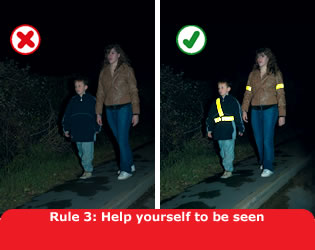
This is a single page version of the British Highway Code. The original can be found at www.gov.uk/highway-code. The repository for this page can be found at github.com/highwaycode/highwayco.de
Pavements (including any path along the side of a road) should be used if provided. Where possible, avoid being next to the kerb with your back to the traffic. If you have to step into the road, look both ways first. Always show due care and consideration for others.
If there is no pavement, keep to the right-hand side of the road so that you can see oncoming traffic. You should take extra care and
It may be safer to cross the road well before a sharp right-hand bend so that oncoming traffic has a better chance of seeing you. Cross back after the bend.
Help other road users to see you. Wear or carry something light-coloured, bright or fluorescent in poor daylight conditions. When it is dark, use reflective materials (e.g. armbands, sashes, waistcoats, jackets, footwear), which can be seen by drivers using headlights up to three times as far away as non-reflective materials.

Young children should not be out alone on the pavement or road (see Rule 7). When taking children out, keep between them and the traffic and hold their hands firmly. Strap very young children into push-chairs or use reins. When pushing a young child in a buggy, do not push the buggy into the road when checking to see if it is clear to cross, particularly from between parked vehicles.
Organised walks. Large groups of people walking together should use a pavement if available; if one is not, they should keep to the left. Look-outs should be positioned at the front and back of the group, and they should wear fluorescent clothes in daylight and reflective clothes in the dark. At night, the look-out in front should show a white light and the one at the back a red light. People on the outside of large groups should also carry lights and wear reflective clothing.
Motorways. Pedestrians MUST NOT be on motorways or slip roads except in an emergency (see Rule 271 and Rule 275).
Laws RTRA sect 17, MT(E&W)R 1982 as amended, reg 15(1)(b) & MT(S)R reg 13
The Green Cross Code. The advice given below on crossing the road is for all pedestrians. Children should be taught the Code and should not be allowed out alone until they can understand and use it properly. The age when they can do this is different for each child. Many children cannot judge how fast vehicles are going or how far away they are. Children learn by example, so parents and carers should always use the Code in full when out with their children. They are responsible for deciding at what age children can use it safely by themselves.
A. First find a safe place to cross and where there is space to reach the pavement on the other side. Where there is a crossing nearby, use it. It is safer to cross using a subway, a footbridge, an island, a zebra, pelican, toucan or puffin crossing, or where there is a crossing point controlled by a police officer, a school crossing patrol or a traffic warden. Otherwise choose a place where you can see clearly in all directions. Try to avoid crossing between parked cars (see Rule 14), on a blind bend, or close to the brow of a hill. Move to a space where drivers and riders can see you clearly. Do not cross the road diagonally.
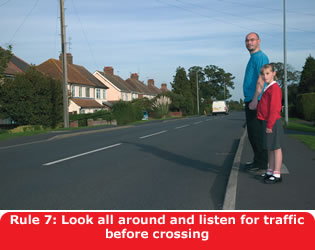
B. Stop just before you get to the kerb, where you can see if anything is coming. Do not get too close to the traffic. If there’s no pavement, keep back from the edge of the road but make sure you can still see approaching traffic.
C. Look all around for traffic and listen. Traffic could come from any direction. Listen as well, because you can sometimes hear traffic before you see it.
D. If traffic is coming, let it pass. Look all around again and listen. Do not cross until there is a safe gap in the traffic and you are certain that there is plenty of time. Remember, even if traffic is a long way off, it may be approaching very quickly.
E. When it is safe, go straight across the road – do not run. Keep looking and listening for traffic while you cross, in case there is any traffic you did not see, or in case other traffic appears suddenly. Look out for cyclists and motorcyclists travelling between lanes of traffic. Do not walk diagonally across the road.
At a junction. When crossing the road, look out for traffic turning into the road, especially from behind you. If you have started crossing and traffic wants to turn into the road, you have priority and they should give way (see Rule 170).
Pedestrian Safety Barriers. Where there are barriers, cross the road only at the gaps provided for pedestrians. Do not climb over the barriers or walk between them and the road.
Tactile paving. Raised surfaces that can be felt underfoot provide warning and guidance to blind or partially sighted people. The most common surfaces are a series of raised studs, which are used at crossing points with a dropped kerb, or a series of rounded raised bars which are used at level crossings, at the top and bottom of steps and at some other hazards.
One-way streets. Check which way the traffic is moving. Do not cross until it is safe to do so without stopping. Bus and cycle lanes may operate in the opposite direction to the rest of the traffic.
Bus and cycle lanes. Take care when crossing these lanes as traffic may be moving faster than in the other lanes, or against the flow of traffic.
Routes shared with cyclists. Some cycle tracks run alongside footpaths or pavements, using a segregating feature to separate cyclists from people on foot. Segregated routes may also incorporate short lengths of tactile paving to help visually impaired people stay on the correct side. On the pedestrian side this will comprise a series of flat-topped bars running across the direction of travel (ladder pattern). On the cyclist side the same bars are orientated in the direction of travel (tramline pattern). Not all routes which are shared with cyclists are segregated. Take extra care where this is so (see Rule 62).
Parked vehicles. If you have to cross between parked vehicles, use the outside edges of the vehicles as if they were the kerb. Stop there and make sure you can see all around and that the traffic can see you. Make sure there is a gap between any parked vehicles on the other side, so you can reach the pavement. Never cross the road in front of, or behind, any vehicle with its engine running, especially a large vehicle, as the driver may not be able to see you.
Reversing vehicles. Never cross behind a vehicle which is reversing, showing white reversing lights or sounding a warning.
Moving vehicles. You MUST NOT get onto or hold onto a moving vehicle.
Law RTA 1988 sect 26
At night. Wear something reflective to make it easier for others to see you (see Rule 3). If there is no pedestrian crossing nearby, cross the road near a street light so that traffic can see you more easily.
At all crossings. When using any type of crossing you should
You MUST NOT loiter on any type of crossing.
Laws ZPPPCRGD reg 19 & RTRA sect 25(5)
Zebra crossings. Give traffic plenty of time to see you and to stop before you start to cross. Vehicles will need more time when the road is slippery. Wait until traffic has stopped from both directions or the road is clear before crossing. Remember that traffic does not have to stop until someone has moved onto the crossing. Keep looking both ways, and listening, in case a driver or rider has not seen you and attempts to overtake a vehicle that has stopped.
![]()
Where there is an island in the middle of a zebra crossing, wait on the island and follow Rule 19 before you cross the second half of the road – it is a separate crossing.
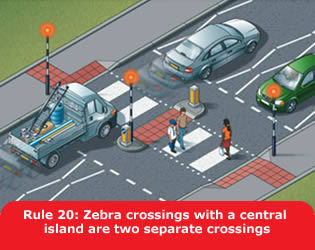
At traffic lights. There may be special signals for pedestrians. You should only start to cross the road when the green figure shows. If you have started to cross the road and the green figure goes out, you should still have time to reach the other side, but do not delay. If no pedestrian signals have been provided, watch carefully and do not cross until the traffic lights are red and the traffic has stopped. Keep looking and check for traffic that may be turning the corner. Remember that traffic lights may let traffic move in some lanes while traffic in other lanes has stopped.

Pelican crossings. These are signal-controlled crossings operated by pedestrians. Push the control button to activate the traffic signals. When the red figure shows, do not cross. When a steady green figure shows, check the traffic has stopped then cross with care. When the green figure begins to flash you should not start to cross. If you have already started you should have time to finish crossing safely.
Puffin crossings differ from pelican crossings as the red and green figures are above the control box on your side of the road and there is no flashing green figure phase. Press the button and wait for the green figure to show.
When the road is congested, traffic on your side of the road may be forced to stop even though their lights are green. Traffic may still be moving on the other side of the road, so press the button and wait for the signal to cross.
Toucan crossings are light-controlled crossings which allow cyclists and pedestrians to share crossing space and cross at the same time. They are push-button operated. Pedestrians and cyclists will see the green signal together. Cyclists are permitted to ride across.
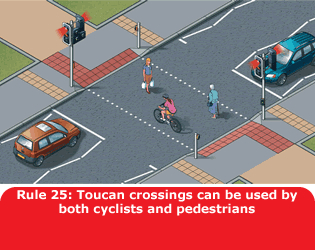
At some crossings there is a bleeping sound or voice signal to indicate to blind or partially sighted people when the steady green figure is showing, and there may be a tactile signal to help deafblind people.
Equestrian crossings are for horse riders. They have pavement barriers, wider crossing spaces, horse and rider figures in the light panels and either two sets of controls (one higher), or just one higher control panel.
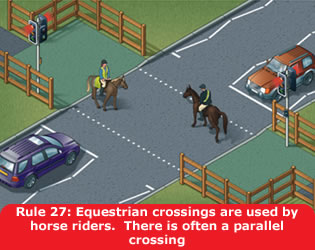
There is often a parallel crossing.
‘Staggered’ pelican or puffin crossings. When the crossings on each side of the central refuge are not in line they are two separate crossings. On reaching the central island, press the button again and wait for a steady green figure.
Image for Rule 28 – Staggered crossings (with an island in the middle) are two
separate crossings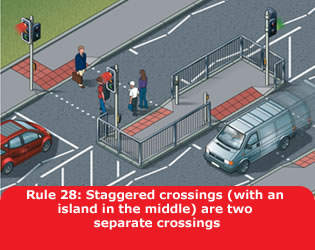
Crossings controlled by an authorised person. Do not cross the road unless you are signalled to do so by a police officer, traffic warden or school crossing patrol. Always cross in front of them.
Where there are no controlled crossing points available it is advisable to cross where there is an island in the middle of the road. Use the Green Cross Code (see Rule 7) to cross to the island and then stop and use it again to cross the second half of the road.
Emergency vehicles. If an ambulance, fire engine, police or other emergency vehicle approaches using flashing blue lights, headlights and/or sirens, keep off the road.
Buses. Get on or off a bus only when it has stopped to allow you to do so. Watch out for cyclists when you are getting off. Never cross the road directly behind or in front of a bus. Wait until it has moved off and you can see clearly in both directions.
Tramways. These may run through pedestrian areas. Their path will be marked out by shallow kerbs, changes in the paving or other road surface, white lines or yellow dots. Cross at designated crossings where provided. Elsewhere treat trams as you would other road vehicles and look both ways along the track before crossing. Do not walk along the track as trams may come up behind you. Trams move quietly and cannot steer to avoid you.
Railway level crossings. You MUST NOT cross or pass a stop line when the red lights show, (including a red pedestrian figure). Also do not cross if an alarm is sounding or the barriers are being lowered. The tone of the alarm may change if another train is approaching. If there are no lights, alarms or barriers, stop, look both ways and listen before crossing. A tactile surface comprising rounded bars running across the direction of pedestrian travel may be installed on the footpath approaching a level crossing to warn visually impaired people of its presence. The tactile surface should extend across the full width of the footway and should be located at an appropriate distance from the barrier or projected line of the barrier.
Law TSRGD, reg 52
Street and pavement repairs. A pavement may be closed temporarily because it is not safe to use. Take extra care if you are directed to walk in or to cross the road.
(Called Invalid Carriages in law)
There is one class of manual wheelchair (called a Class 1 invalid carriage) and two classes of powered wheelchairs and powered mobility scooters. Manual wheelchairs and Class 2 vehicles are those with an upper speed limit of 4 mph (6 km/h) and are designed to be used on pavements. Class 3 vehicles are those with an upper speed limit of 8 mph (12 km/h) and are equipped to be used on the road as well as the pavement.
When you are on the road you should obey the guidance and rules for other vehicles; when on the pavement you should follow the guidance and rules for pedestrians.
Pavements are safer than roads and should be used when available. You should give pedestrians priority and show consideration for other pavement users, particularly those with a hearing or visual impairment who may not be aware that you are there.
Powered wheelchairs and scooters MUST NOT travel faster than 4 mph (6 km/h) on pavements or in pedestrian areas. You may need to reduce your speed to adjust to other pavement users who may not be able to move out of your way quickly enough or where the pavement is too narrow.
Law UICHR 1988 reg 4
When moving off the pavement onto the road, you should take special care. Before moving off, always look round and make sure it’s safe to join the traffic. Always try to use dropped kerbs when moving off the pavement, even if this means travelling further to locate one. If you have to climb or descend a kerb, always approach it at right angles and don’t try to negotiate a kerb higher than the vehicle manufacturer’s recommendations.
You should take care when travelling on the road as you may be travelling more slowly than other traffic (your machine is restricted to 8 mph (12 km/h) and may be less visible).
When on the road, Class 3 vehicles should travel in the direction of the traffic. Class 2 users should always use the pavement when it is available. When there is no pavement, you should use caution when on the road. Class 2 users should, where possible, travel in the direction of the traffic. If you are travelling at night when lights MUST be used, you should travel in the direction of the traffic to avoid confusing other road users.
Law UICHR 1988 reg 9
You MUST follow the same rules about using lights, indicators and horns as for other road vehicles, if your vehicle is fitted with them. At night, lights MUST be used. Be aware that other road users may not see you and you should make yourself more visible - even in the daytime and also at dusk - by, for instance, wearing a reflective jacket or reflective strips on the back of the vehicle.
Law UICHR 1988 reg 9
Take extra care at road junctions. When going straight ahead, check to make sure there are no vehicles about to cross your path from the left, the right, or overtaking you and turning left. There are several options for dealing with right turns, especially turning from a major road. If moving into the middle of the road is difficult or dangerous, you can - stop on the left-hand side of the road and wait for a safe gap in the traffic - negotiate the turn as a pedestrian, i.e. travel along the pavement and cross the road between pavements where it is safe to do so. Class 3 users should switch the vehicle to the lower speed limit when on pavements.
If the junction is too hazardous, it may be worth considering an alternative route. Similarly, when negotiating major roundabouts (i.e. with two or more lanes) it may be safer for you to use the pavement or find a route which avoids the roundabout altogether.
All normal parking restrictions should be observed. Your vehicle should not be left unattended if it causes an obstruction to other pedestrians - especially those in wheelchairs. Parking concessions provided under the Blue Badge scheme (see Further reading and conversions) will apply to those vehicles displaying a valid badge.
These vehicles MUST NOT be used on motorways (see Rule 253). They should not be used on unrestricted dual carriageways where the speed limit exceeds 50 mph (80 km/h) but if they are used on these dual carriageways, they MUST have a flashing amber beacon. A flashing amber beacon should be used on all other dual carriageways (see Rule 220).
Laws RTRA sect 17(2) & (3), & RVLR reg 17(1) & 26
Horse-drawn vehicles used on the highway should be operated and maintained in accordance with standards set out in the Department for Transport’s Code of Practice for Horse-Drawn Vehicles. This Code lays down the requirements for a road driving assessment and includes a comprehensive list of safety checks to ensure that a carriage and its fittings are safe and in good working order. The standards set out in the Road Driving Assessment may be required to be met by a Local Authority if an operator wishes to obtain a local authority licence to operate a passenger-carrying service.
Safety equipment and clothing. All horse-drawn vehicles should have two red rear reflectors. It is safer not to drive at night but if you do, a light showing white to the front and red to the rear MUST be fitted.
Law RVLR 1989 reg 4
Safety equipment. Children under the age of 14 MUST wear a helmet which complies with the Regulations. It MUST be fastened securely. Other riders should also follow these requirements. These requirements do not apply to a child who is a follower of the Sikh religion while wearing a turban.
Laws H(PHYR) Act 1990, sect 1 & H(PHYR) Regulations 1992, reg 3
Other clothing. You should wear
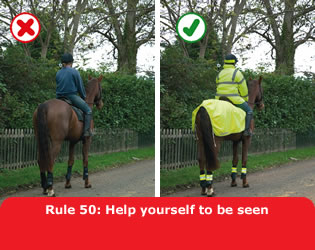
At night. It is safer not to ride on the road at night or in poor visibility, but if you do, make sure you wear reflective clothing and your horse has reflective bands above the fetlock joints. A light which shows white to the front and red to the rear should be fitted, with a band, to the rider’s right arm and/or leg/riding boot. If you are leading a horse at night, carry a light in your right hand, showing white to the front and red to the rear, and wear reflective clothing on both you and your horse. It is strongly recommended that a fluorescent/reflective tail guard is also worn by your horse.
Before you take a horse on to a road, you should
Always ride with other, less nervous horses if you think that your horse will be nervous of traffic. Never ride a horse without both a saddle and bridle.
Before riding off or turning, look behind you to make sure it is safe, then give a clear arm signal.
When riding on the road you should
You MUST NOT take a horse onto a footpath or pavement, and you should not take a horse onto a cycle track. Use a bridleway where possible. Equestrian crossings may be provided for horse riders to cross the road and you should use these where available (see Crossings). You should dismount at level crossings where a ‘horse rider dismount’ sign is displayed.
Laws HA 1835 sect 72, R(S)A 1984, sect 129(5)
Avoid roundabouts wherever possible. If you use them you should - keep to the left and watch out for vehicles crossing your path to leave or join the roundabout - signal right when riding across exits to show you are not leaving - signal left just before you leave the roundabout.
Dogs. Do not let a dog out on the road on its own. Keep it on a short lead when walking on the pavement, road or path shared with cyclists or horse riders.
When in a vehicle make sure dogs or other animals are suitably restrained so they cannot distract you while you are driving or injure you, or themselves, if you stop quickly. A seat belt harness, pet carrier, dog cage or dog guard are ways of restraining animals in cars.
Animals being herded. These should be kept under control at all times. You should, if possible, send another person along the road in front to warn other road users, especially at a bend or the brow of a hill. It is safer not to move animals after dark, but if you do, then wear reflective clothing and ensure that lights are carried (white at the front and red at the rear of the herd).
These rules are in addition to those in the following sections, which apply to all vehicles (except the motorway section). See also You and your bicycle.
Clothing. You should wear
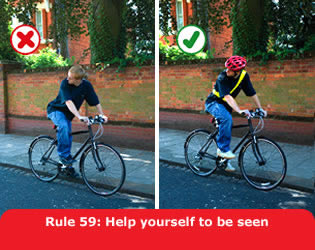
At night your cycle MUST have white front and red rear lights lit. It MUST also be fitted with a red rear reflector (and amber pedal reflectors, if manufactured after 1/10/85). White front reflectors and spoke reflectors will also help you to be seen. Flashing lights are permitted but it is recommended that cyclists who are riding in areas without street lighting use a steady front lamp.
Law RVLR regs 13, 18 & 24
Cycle Routes and Other Facilities. Use cycle routes, advanced stop lines, cycle boxes and toucan crossings unless at the time it is unsafe to do so. Use of these facilities is not compulsory and will depend on your experience and skills, but they can make your journey safer.
Cycle Tracks. These are normally located away from the road, but may occasionally be found alongside footpaths or pavements. Cyclists and pedestrians may be segregated or they may share the same space (unsegregated). When using segregated tracks you MUST keep to the side intended for cyclists as the pedestrian side remains a pavement or footpath. Take care when passing pedestrians, especially children, older or disabled people, and allow them plenty of room. Always be prepared to slow down and stop if necessary. Take care near road junctions as you may have difficulty seeing other road users, who might not notice you.
Law HA 1835 sect 72
Cycle Lanes. These are marked by a white line (which may be broken) along the carriageway (see Rule 140). Keep within the lane when practicable. When leaving a cycle lane check before pulling out that it is safe to do so and signal your intention clearly to other road users. Use of cycle lanes is not compulsory and will depend on your experience and skills, but they can make your journey safer.
You MUST NOT cycle on a pavement.
Laws HA 1835 sect 72 & R(S)A 1984, sect 129
Bus Lanes. Most bus lanes may be used by cyclists as indicated on signs. Watch out for people getting on or off a bus. Be very careful when overtaking a bus or leaving a bus lane as you will be entering a busier traffic flow. Do not pass between the kerb and a bus when it is at a stop.
You should
You should
You MUST NOT
You MUST obey all traffic signs and traffic light signals.
Laws RTA 1988 sect 36 & TSRGD reg 10(1)
When parking your cycle
You MUST NOT cross the stop line when the traffic lights are red. Some junctions have an advanced stop line to enable you to wait and position yourself ahead of other traffic (see Rule 178).
Laws RTA 1988 sect 36 & TSRGD regs 10 & 36(1)
On the left. When approaching a junction on the left, watch out for vehicles turning in front of you, out of or into the side road. Just before you turn, check for undertaking cyclists or motorcyclists. Do not ride on the inside of vehicles signalling or slowing down to turn left.
Pay particular attention to long vehicles which need a lot of room to manoeuvre at corners. Be aware that drivers may not see you. They may have to move over to the right before turning left. Wait until they have completed the manoeuvre because the rear wheels come very close to the kerb while turning. Do not be tempted to ride in the space between them and the kerb.
On the right. If you are turning right, check the traffic to ensure it is safe, then signal and move to the centre of the road. Wait until there is a safe gap in the oncoming traffic and give a final look before completing the turn. It may be safer to wait on the left until there is a safe gap or to dismount and push your cycle across the road.
Dual carriageways. Remember that traffic on most dual carriageways moves quickly. When crossing wait for a safe gap and cross each carriageway in turn. Take extra care when crossing slip roads.
Full details about the correct procedure at roundabouts are contained in (see Rules 184, 185, 186, 187, 188, 188 and 190). Roundabouts can be hazardous and should be approached with care.
You may feel safer walking your cycle round on the pavement or verge. If you decide to ride round keeping to the left-hand lane you should
Give plenty of room to long vehicles on the roundabout as they need more space to manoeuvre. Do not ride in the space they need to get round the roundabout. It may be safer to wait until they have cleared the roundabout.
Do not ride across equestrian crossings, as they are for horse riders only. Do not ride across a pelican, puffin or zebra crossing. Dismount and wheel your cycle across.
Toucan crossings. These are light-controlled crossings which allow cyclists and pedestrians to share crossing space and cross at the same time. They are push-button operated. Pedestrians and cyclists will see the green signal together. Cyclists are permitted to ride across.
Cycle-only crossings. Cycle tracks on opposite sides of the road may be linked by signalled crossings. You may ride across but you MUST NOT cross until the green cycle symbol is showing.
Law TSRGD regs 33(2) & 36(1)
Level crossings/Tramways. Take extra care when crossing the tracks (see Rule 306). You should dismount at level crossings where a ‘cyclist dismount’ sign is displayed.
Make sure that you feel confident of your ability to ride safely on the road. Be sure that
It is recommended that you fit a bell to your cycle.
You MUST
Cycle training can help both children and adults, especially those adults returning to cycling to develop the skills needed to cycle safely on today’s roads. A new national cycle training standard has been developed which the Government is promoting and making funding available for delivery in schools.
All cyclists should consider the benefits of undertaking cycle training. For information, contact your local authority.
These Rules are in addition to those in the following sections which apply to all vehicles. See Motorcycle licence requirements).
On all journeys, the rider and pillion passenger on a motorcycle, scooter or moped MUST wear a protective helmet. This does not apply to a follower of the Sikh religion while wearing a turban. Helmets MUST comply with the Regulations and they MUST be fastened securely. Riders and passengers of motor tricycles and quadricycles, also called quadbikes, should also wear a protective helmet. Before each journey check that your helmet visor is clean and in good condition.
Laws RTA 1988 sects 16 & 17 & MC(PH)R as amended reg 4
It is also advisable to wear eye protectors, which MUST comply with the Regulations. Scratched or poorly fitting eye protectors can limit your view when riding, particularly in bright sunshine and the hours of darkness. Consider wearing ear protection. Strong boots, gloves and suitable clothing may help to protect you if you are involved in a collision.
Laws RTA sect 18 & MC(EP)R as amended reg 4
You MUST NOT carry more than one pillion passenger who MUST sit astride the machine on a proper seat. They should face forward with both feet on the footrests. You MUST NOT carry a pillion passenger unless your motor cycle is designed to do so. Provisional licence holders MUST NOT carry a pillion passenger.
Laws RTA 1988 sect 23, MV(DL)R 1999 reg 16(6) & CUR 1986 reg 102
Daylight riding. Make yourself as visible as possible from the side as well as the front and rear. You could wear a light or brightly coloured helmet and fluorescent clothing or strips. Dipped headlights, even in good daylight, may also make you more conspicuous. However, be aware that other vehicle drivers may still not have seen you, or judged your distance or speed correctly, especially at junctions.
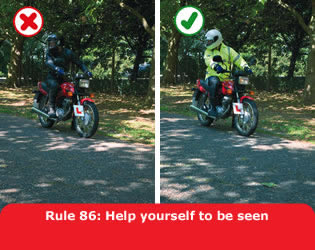
Riding in the dark. Wear reflective clothing or strips to improve your visibility in the dark. These reflect light from the headlamps of other vehicles, making you visible from a longer distance. See Rules 113, 114, 115 and 116 for lighting requirements.
Manoeuvring. You should be aware of what is behind and to the sides before manoeuvring. Look behind you; use mirrors if they are fitted. When in traffic queues look out for pedestrians crossing between vehicles and vehicles emerging from junctions or changing lanes. Position yourself so that drivers in front can see you in their mirrors. Additionally, when filtering in slow-moving traffic, take care and keep your speed low.
Remember: Observation – Signal – Manoeuvre.
If you have a provisional motorcycle licence, you MUST satisfactorily complete a Compulsory Basic Training (CBT) course.
You can then ride unaccompanied on the public road a motorcycle up to 125 cc, with a power output not exceeding 11 kW, with L plates (in Wales either D plates or L plates, or both, can be used), for up to two years.
To ride a moped, learners MUST:
You can then ride unaccompanied on the public road a two-wheeled vehicle with a maximum design speed of 45 km/h (28 mph), with L plates (in Wales either D plates or L plates, or both, can be used), for up to two years.
You MUST first pass the theory test for motorcycles and then the moped practical test to obtain your full moped licence.
If you passed your car driving test before 1 February 2001 you are qualified to ride a moped without L plates (and/or D plates in Wales), although it is recommended that you complete CBT before riding on the road. If you passed your car driving test after this date you MUST complete CBT before riding a moped on the road.
Category AM (moped) – minimum age 16
Category A1 – minimum age 17
Category A2 – minimum age 19
Category A
Progressive access is a process that allows a rider to take a higher-category practical test if they already have at least two years’ experience on a lower-category motorcycle. For example, if you have held a category A2 licence for a minimum of two years, you can take the category A practical test at age 21. There is no requirement to take another theory test.
If you want to learn to ride motorcycles larger than 125 cc and with a power output over 11 kW, you MUST meet the minimum age requirements, satisfactorily complete a CBT course and be accompanied by an approved instructor on another motorcycle in radio contact.
To obtain your full moped or motorcycle licence you MUST pass a motorcycle theory test and modules 1 and 2 practical tests on a two-wheeled motorcycle.
You MUST NOT carry a pillion passenger or pull a trailer until you have passed your test. Also see Rule 253 covering vehicles prohibited from motorways.
Law MV(DL)R reg 16
Vehicle condition. You MUST ensure your vehicle and trailer comply with the full requirements of the Road Vehicles (Construction and Use) Regulations and Road Vehicles Lighting Regulations (see The road user and the law).
Make sure that you are fit to drive. You MUST report to the Driver and Vehicle Licensing Agency (DVLA) any health condition likely to affect your driving.
Law RTA 1988 sect 94
Driving when you are tired greatly increases your risk of collision. To minimise this risk
Vision. You MUST be able to read a vehicle number plate, in good daylight, from a distance of 20 metres (or 20.5 metres where the old style number plate is used). If you need to wear glasses (or contact lenses) to do this, you MUST wear them at all times while driving. The police have the power to require a driver to undertake an eyesight test.
Laws RTA 1988 sect 96 & MV(DL)R reg 40 & sch 8
Slow down, and if necessary stop, if you are dazzled by bright sunlight.
At night or in poor visibility, do not use tinted glasses, lenses or visors if they restrict your vision.
Do not drink and drive as it will seriously affect your judgement and abilities. You MUST NOT drive with a breath alcohol level higher than 35 microgrammes/100 millilitres of breath or a blood alcohol level of more than 80 milligrammes/100 millilitres of blood. Alcohol will
The best solution is not to drink at all when planning to drive because any amount of alcohol affects your ability to drive safely. If you are going to drink, arrange another means of transport.
Law RTA 1988 sects 4, 5 & 11(2)
You MUST NOT drive under the influence of drugs or medicine. Check the instructions or ask your doctor or pharmacist. Using illegal drugs is highly dangerous. Never take them if you intend to drive; the effects are unpredictable, but can be even more severe than alcohol and may result in fatal or serious road crashes.
Law RTA 1988 sect 4
Before setting off. You should ensure that
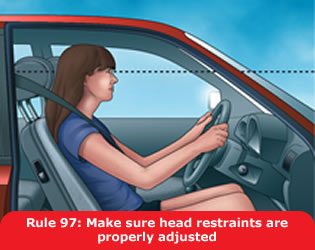
Vehicle towing and loading. As a driver
In the event of a breakdown, be aware that towing a vehicle on a tow rope is potentially dangerous. You should consider professional recovery.
Laws CUR reg 100 & MV(DL)R reg 43
You MUST wear a seat belt in cars, vans and other goods vehicles if one is fitted (see table below). Adults, and children aged 14 years and over, MUST use a seat belt or child restraint, where fitted, when seated in minibuses, buses and coaches. Exemptions are allowed for the holders of medical exemption certificates and those making deliveries or collections in goods vehicles when travelling less than 50 metres (approx 162 feet).
Laws RTA 1988 sects 14 & 15, MV(WSB)R, MV(WSBCFS)R & MV(WSB)(A)R
Seat Belt Requirements. This table summarises the main legal requirements for wearing seat belts in cars, vans and other goods vehicles.
| Seat Belt Requirements | Front seat | Rear seat | Who is responsible? |
|---|---|---|---|
| Driver | Seat belt MUST be worn if fitted | Driver | |
| Child under 3 years of age | Correct child restraint MUST be used | Correct child restraint MUST be used. If one is not available in a taxi, may travel unrestrained. | Driver |
| Child from 3rd birthday up to 1.35 metres in height (or 12th birthday, whichever they reach first) | Correct child restraint MUST be used | Correct child restraint MUST be used where seat belts fitted. MUST use adult belt if correct child restraint is not available in a licensed taxi or private hire vehicle, or for reasons of unexpected necessity over a short distance, or if two occupied restraints prevent fitment of a third. | Driver |
| Child over 1.35 metres (approx 4ft 5ins) in height or 12 or 13 years | Adult seat belt MUST be worn if available | Adult seat belt MUST be worn if available | Driver |
| Adult passengers aged 14 and over | Seat belt MUST be worn if available | Seat belt MUST be worn if available | Passenger |
The driver MUST ensure that all children under 14 years of age in cars, vans and other goods vehicles wear seat belts or sit in an approved child restraint where required (see table above). If a child is under 1.35 metres (approx 4 feet 5 inches) tall, a baby seat, child seat, booster seat or booster cushion MUST be used suitable for the child’s weight and fitted to the manufacturer’s instructions.
Laws RTA 1988 sects 14 & 15, MV(WSB)R, MV(WSBCFS)R & MV(WSB)(A)R

A rear-facing baby seat MUST NOT be fitted into a seat protected by an active frontal airbag, as in a crash it can cause serious injury or death to the child.
Laws RTA 1988 sects 14 & 15, MV(WSB)R, MV(WSBCFS)R & MV(WSB)(A)R
Children in cars, vans and other goods vehicles. Drivers who are carrying children in cars, vans and other goods vehicles should also ensure that
If you have a provisional motorcycle licence, you MUST satisfactorily complete a Compulsory Basic Training (CBT) course. You can then ride a motorcycle up to 125 cc with a power output not exceeding 11 kW on the public road, with L plates (in Wales either D plates, L plates or both can be used), for up to two years. Under direct access you can practise on a motorcycle that exceeds 125 cc provided that
To obtain your full motorcycle licence you MUST pass a motorcycle theory test and then a practical test.
Law MV(DL)R regs 16 & 68
A1 motorcycle licence: At age 17 or over, you take a test on a motorcycle without sidecar of between 120 and 125 cc. If you pass you may ride a motorcycle up to 125 cc with power output up to 11 kW, or a motor tricycle with power not exceeding 15 kW.
A2 motorcycle licence: At age 19 or over, you take a test on a motorcycle without sidecar of at least 395 cc with a power output of at least 25 kW but not exceeding 35 kW. If you pass, you may ride any motorcycle not exceeding 35 kW and with a power to weight ratio not exceeding 0.2 kW/kg.
Full A motorcycle licence: Test taken on a motorcycle without sidecar, of at least 595 cc and an engine power of at least 40 kW This gives you full access to all motorcycles and motor tricycles. You obtain a category A licence by taking progressive access from age 21, or under the direct access scheme from age 24.
Category A under progressive access: You can take a category A practical test at age 21 if you already have an A2 licence that you’ve held for a minimum of two years. You don’t need to take another theory test or hold a CBT certificate.
Category A under direct access: This is for riders aged 24 or over. To obtain a category A licence you MUST
Passing the practical test on a motorcycle of at least 40 kW (53.6bhp) gives immediate access to all sizes of motorcycle.
You MUST NOT carry a pillion passenger or pull a trailer until you have passed your test. Also see Rule 253 covering vehicles prohibited from motorways.
Law MV(DL)R reg 16
A moped MUST have an engine capacity not exceeding 50 cc, not weigh more than 250kg and be designed to have a maximum speed not exceeding 28mph (45 km/h). Before June 2003 a licence allowed the riding of mopeds up to 50km/h.
To ride a moped, learners MUST
You MUST first pass the theory test for motorcycles and then the moped practical test to obtain your full moped licence. If you passed your car driving test before 1 February 2001 you are qualified to ride a moped without L plates (and/or D plates in Wales), although it is recommended that you complete CBT before riding on the road. If you passed your car driving test after this date you MUST complete CBT before riding a moped on the road.
Laws RTA 1988 sects 97(e) & 101 & MV(DL)R regs 38(4) & 43
Driving licence. You MUST have a valid driving licence for the category of motor vehicle you are driving. You MUST inform the Driver and Vehicle Licensing Agency (DVLA) if you change your name and/or address.
Law RTA 1988 sects 87 & 99(4)
Holders of non-European Community licences who are now resident in the UK may only drive on that licence for a maximum of 12 months from the date they become resident in this country. To ensure continuous driving entitlement
MOT. Cars and motorcycles MUST normally pass an MOT test three years from the date of the first registration and every year after that. You MUST NOT drive a motor vehicle without an MOT certificate when it should have one. Exceptionally, you may drive to a pre-arranged test appointment or to a garage for repairs required for the test. Driving an unroadworthy motor vehicle may invalidate your insurance. From November 2012, motor vehicles manufactured before 1960 will be exempted from an MOT requirement, although they can still be submitted for a test voluntarily. Owners are still legally required to ensure their vehicle is safe and roadworthy.
Law RTA 1988 sects 45, 47, 49 & 53
Insurance. To use a motor vehicle on the road, you MUST have a valid insurance policy. This MUST at least cover you for injury or damage to a third party while using that motor vehicle. Before driving any motor vehicle, make sure that it has this cover for your use or that your own insurance provides adequate cover. You MUST NOT drive a motor vehicle without insurance. Also, be aware that even if a road traffic incident is not your fault, you may still be held liable by insurance companies.
Law RTA 1988 sect 143
Uninsured drivers can now be automatically detected by roadside cameras. Further to the penalties for uninsured driving listed on page 126, an offender’s vehicle can now be seized by the Police, taken away and crushed. Law RTA 1988, sects 165a & 165b
The types of cover available are indicated below:
Third-Party insurance - this is often the cheapest form of insurance, and is the minimum cover required by law. It covers anyone you might injure or whose property you might damage. It does not cover damage to your own motor vehicle or injury to yourself.
Third-Party, Fire and Theft insurance - similar to third-party, but also covers you against your motor vehicle being stolen, or damaged by fire.
Comprehensive insurance - this is the most expensive but the best insurance. Apart from covering other persons and property against injury or damage, it also covers damage to your own motor vehicle, up to the market value of that vehicle, and personal injury to yourself.
Registration certificate. Registration certificates (also called harmonised registration certificates) are issued for all motor vehicles used on the road, describing them (make, model, etc) and giving details of the registered keeper. You MUST notify the Driver and Vehicle Licensing Agency in Swansea as soon as possible when you buy or sell a motor vehicle, or if you change your name or address. For registration certificates issued after 27 March 1997, the buyer and seller are responsible for completing the registration certificates. The seller is responsible for forwarding them to DVLA. The procedures are explained on the back of the registration certificates.
Law RV(R&L)R regs 21, 22, 23 & 24
Vehicle Excise Duty (VED). Vehicle Excise Duty MUST be paid on all motor vehicles used or kept on public roads. From 1 October 2014 paper tax discs will no longer be issued.
Law VERA sects 29 and 33
Statutory Off-Road Notification (SORN). This is a notification to the DVLA that a motor vehicle is not being used on the road. If you are the vehicle keeper and want to keep a motor vehicle untaxed and off the public road you MUST declare SORN - it is an offence not to do so. The vehicle will remain SORN until you sell, tax or scrap it. If your vehicle is unused or off the road it MUST have either a SORN declaration or valid insurance. Law RV(RL)R 2002, reg 26 sched 4
Production of documents. You MUST be able to produce your driving licence and counterpart, a valid insurance certificate and (if appropriate) a valid MOT certificate, when requested by a police officer. If you cannot do this you may be asked to take them to a police station within seven days.
Law RTA 1988 sects 164 & 165
Learners driving a car MUST hold a valid provisional licence. They MUST be supervised by someone at least 21 years old who holds a full EC/EEA licence for that type of car (automatic or manual) and has held one for at least three years.
Laws MV(DL)R reg 16 & RTA 1988 sect 87
Vehicles. Any vehicle driven by a learner MUST display red L plates. In Wales, either red D plates, red L plates, or both, can be used. Plates MUST conform to legal specifications and MUST be clearly visible to others from in front of the vehicle and from behind. Plates should be removed or covered when not being driven by a learner (except on driving school vehicles).
Law MV(DL)R reg 16 & sched 4
You MUST pass the theory test (if one is required) and then a practical driving test for the category of vehicle you wish to drive before driving unaccompanied.
Law MV(DL)R reg 40
This section should be read by all drivers, motorcyclists, cyclists and horse riders. The rules in The Highway Code do not give you the right of way in any circumstance, but they advise you when you should give way to others. Always give way if it can help to avoid an incident.
Signals warn and inform other road users, including pedestrians (see ‘Signals to other road users’), of your intended actions. You should always
You should also
You MUST obey signals given by police officers, traffic officers, traffic wardens (see ‘Signals by authorised persons’). and signs used by school crossing patrols.
Laws RTRA sect 28, RTA 1988 sect 35, TMA 2004 sect 6, & FTWO art 3
Police stopping procedures. If the police want to stop your vehicle they will, where possible, attract your attention by
You MUST then pull over and stop as soon as it is safe to do so. Then switch off your engine.
Law RTA 1988 sect 163
Vehicle & Operator Services Agency Officers (to be called Driver and Vehicle Standards Agency Officers from 2 April 2014) have powers to stop vehicles on all roads, including motorways and trunk roads, in England and Wales. They will attract your attention by flashing amber lights
It is an offence not to comply with their directions. You MUST obey any signals given (see ‘Signals by authorised persons’).
Laws RTA 1988, sect 67, & PRA 2002, sect 41 & sched 5(8)
Highways Agency Traffic Officers have powers to stop vehicles on most motorways and some ‘A’ class roads, in England only. If HA traffic officers in uniform want to stop your vehicle on safety grounds (e.g. an insecure load) they will, where possible, attract your attention by
You MUST then pull over and stop as soon as it is safe to do so. Then switch off your engine. It is an offence not to comply with their directions (see ‘Signals by authorised persons’).
Law RTA1988, sects 35 &163 as amended by TMA 2004, sect 6
Traffic light signals and traffic signs. You MUST obey all traffic light signals (see ‘Light signals controlling traffic’) and traffic signs giving orders, including temporary signals & signs (see ‘Traffic signs’). Make sure you know, understand and act on all other traffic and information signs and road markings (see ‘Road markings’) and Vehicle markings’).
Laws RTA 1988 sect 36 & TSRGD regs 10, 15, 16, 25, 26, 27, 28, 29, 36, 38 & 40
Flashing headlights. Only flash your headlights to let other road users know that you are there. Do not flash your headlights to convey any other message or intimidate other road users.
Never assume that flashing headlights is a signal inviting you to proceed. Use your own judgement and proceed carefully.
The horn. Use only while your vehicle is moving and you need to warn other road users of your presence. Never sound your horn aggressively. You MUST NOT use your horn
except when another road user poses a danger.
Law CUR reg 99
You MUST
Night (the hours of darkness) is defined as the period between half an hour after sunset and half an hour before sunrise).
Laws RVLR regs 3, 24, & 25, (In Scotland - RTRA 1984 sect 82 (as amended by NRSWA, para 59 of sched 8))
You MUST NOT
In stationary queues of traffic, drivers should apply the parking brake and, once the following traffic has stopped, take their foot off the footbrake to deactivate the vehicle brake lights. This will minimise glare to road users behind until the traffic moves again.
Law RVLR reg 27
You should also
Hazard warning lights. These may be used when your vehicle is stationary, to warn that it is temporarily obstructing traffic. Never use them as an excuse for dangerous or illegal parking. You MUST NOT use hazard warning lights while driving or being towed unless you are on a motorway or unrestricted dual carriageway and you need to warn drivers behind you of a hazard or obstruction ahead. Only use them for long enough to ensure that your warning has been observed.
Law RVLR reg 27
In normal circumstances. The safest way to brake is to do so early and lightly. Brake more firmly as you begin to stop. Ease the pressure off just before the vehicle comes to rest to avoid a jerky stop.
In an emergency. Brake immediately. Try to avoid braking so harshly that you lock your wheels. Locked wheels can lead to loss of control.
Skids. Skidding is usually caused by the driver braking, accelerating or steering too harshly or driving too fast for the road conditions. If skidding occurs, remove the cause by releasing the brake pedal fully or easing off the accelerator. Turn the steering wheel in the direction of the skid. For example, if the rear of the vehicle skids to the right, steer immediately to the right to recover.
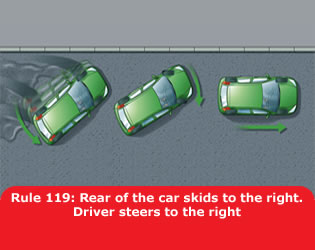
ABS. If your vehicle is fitted with anti-lock brakes, you should follow the advice given in the vehicle handbook. However, in the case of an emergency, apply the footbrake firmly; do not release the pressure until the vehicle has slowed to the desired speed. The ABS should ensure that steering control will be retained, but do not assume that a vehicle with ABS will stop in a shorter distance.
Brakes affected by water. If you have driven through deep water your brakes may be less effective. Test them at the first safe opportunity by pushing gently on the brake pedal to make sure that they work. If they are not fully effective, gently apply light pressure while driving slowly. This will help to dry them out.
Coasting. This term describes a vehicle travelling in neutral or with the clutch pressed down. It can reduce driver control because
You MUST NOT leave a parked vehicle unattended with the engine running or leave a vehicle engine running unnecessarily while that vehicle is stationary on a public road. Generally, if the vehicle is stationary and is likely to remain so for more than a couple of minutes, you should apply the parking brake and switch off the engine to reduce emissions and noise pollution. However it is permissible to leave the engine running if the vehicle is stationary in traffic or for diagnosing faults.
Law CUR regs 98 & 107
You MUST NOT exceed the maximum speed limits for the road and for your vehicle (see the table below). The presence of street lights generally means that there is a 30 mph (48 km/h) speed limit unless otherwise specified.
Law RTRA sects 81, 86, 89 & sch 6
The speed limit is the absolute maximum and does not mean it is safe to drive at that speed irrespective of conditions. Driving at speeds too fast for the road and traffic conditions is dangerous. You should always reduce your speed when
Speed Limits
| Type of vehicle | Built-up areas* | Single carriageways | Dual carriageways | Motorways |
| MPH (km/h) | MPH (km/h) | MPH (km/h) | MPH (km/h) | |
| Cars & motorcycles (including car derived vans up to 2 tonnes maximum laden weight) | 30 (48) | 60 (96) | 70 (112) | 70 (112) |
| Cars towing caravans or trailers (including car derived vans and motorcycles) | 30 (48) | 50 (80) | 60 (96) | 60 (95) |
| Buses, coaches and minibuses (not exceeding 12 metres in overall length | 30 (48) | 50 (80) | 60 (96) | 70 (112) |
| Goods vehicles (not exceeding 7.5 tonnes maximum laden weight) | 30 (48) | 50 (80) | 60 (96) | 70† (112) |
| Goods vehicles (exceeding 7.5 tonnes maximum laden weight) | 30 (48) | 40 (64) | 50 (80) | 60 (96) |
*The 30 mph limit usually applies to all traffic on all roads with street lighting unless signs show otherwise. †60 mph (96 km/h) if articulated or towing a trailer
Stopping Distances. Drive at a speed that will allow you to stop well within the distance you can see to be clear. You should
If you have to stop in a tunnel, leave at least a 5-metre gap between you and the vehicle in front.

See ‘Typical stopping distances’.
See ‘Road markings’ to see diagrams of all lines.
A broken white line. This marks the centre of the road. When this line lengthens and the gaps shorten, it means that there is a hazard ahead. Do not cross it unless you can see the road is clear and wish to overtake or turn off.
Double white lines where the line nearest to you is broken. This means you may cross the lines to overtake if it is safe, provided you can complete the manoeuvre before reaching a solid white line on your side. White direction arrows on the road indicate that you need to get back onto your side of the road.
Double white lines where the line nearest you is solid. This means you MUST NOT cross or straddle it unless it is safe and you need to enter adjoining premises or a side road. You may cross the line if necessary, provided the road is clear, to pass a stationary vehicle, or overtake a pedal cycle, horse or road maintenance vehicle, if they are travelling at 10 mph (16 km/h) or less.
Laws RTA 1988 sect 36 & TSRGD regs 10 & 26
Areas of white diagonal stripes or chevrons painted on the road. These are to separate traffic lanes or to protect traffic turning right.
Lane dividers. These are short, broken white lines which are used on wide carriageways to divide them into lanes. You should keep between them.
Reflective road studs may be used with white lines.
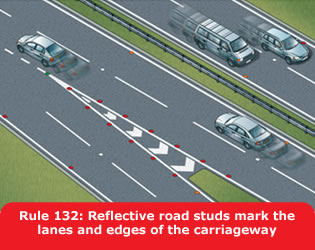
If you need to change lane, first use your mirrors and if necessary take a quick sideways glance to make sure you will not force another road user to change course or speed. When it is safe to do so, signal to indicate your intentions to other road users and when clear, move over.
You should follow the signs and road markings and get into the lane as directed. In congested road conditions do not change lanes unnecessarily. Merging in turn is recommended but only if safe and appropriate when vehicles are travelling at a very low speed, e.g. when approaching road works or a road traffic incident. It is not recommended at high speed.
Where a single carriageway has three lanes and the road markings or signs do not give priority to traffic in either direction
Where a single carriageway has four or more lanes, use only the lanes that signs or markings indicate.
A dual carriageway is a road which has a central reservation to separate the carriageways.
On a two-lane dual carriageway you should stay in the left-hand lane. Use the right-hand lane for overtaking or turning right. After overtaking, move back to the left-hand lane when it is safe to do so.
On a three-lane dual carriageway, you may use the middle lane or the right-hand lane to overtake but return to the middle and then the left-hand lane when it is safe.
Climbing and crawler lanes. These are provided on some hills. Use this lane if you are driving a slow-moving vehicle or if there are vehicles behind you wishing to overtake. Be aware of the signs and road markings which indicate the lane is about to end.
Cycle lanes. These are shown by road markings and signs. You MUST NOT drive or park in a cycle lane marked by a solid white line during its times of operation. Do not drive or park in a cycle lane marked by a broken white line unless it is unavoidable. You MUST NOT park in any cycle lane whilst waiting restrictions apply.
Law RTRA sects 5 & 8
Bus lanes. These are shown by road markings and signs that indicate which (if any) other vehicles are permitted to use the bus lane. Unless otherwise indicated, you should not drive in a bus lane during its period of operation. You may enter a bus lane to stop, to load or unload where this is not prohibited.
High-occupancy vehicle lanes and other designated vehicle lanes. Lanes may be restricted for use by particular types of vehicle; these restrictions may apply some or all of the time. The operating times and vehicle types will be indicated on the accompanying traffic signs. You MUST NOT drive in such lanes during their times of operation unless signs indicate that your vehicle is permitted.
See ‘Traffic signs’ to see diagrams of traffic signs.
Vehicles permitted to use designated lanes may or may not include cycles, buses, taxis, licensed private hire vehicles, motorcycles, heavy goods vehicles (HGVs) and high-occupancy vehicles (HOVs). Where HOV lanes are in operation, they MUST ONLY be used by
One-way streets. Traffic MUST travel in the direction indicated by signs. Buses and/or cycles may have a contraflow lane. Choose the correct lane for your exit as soon as you can. Do not change lanes suddenly. Unless road signs or markings indicate otherwise, you should use
Remember – traffic could be passing on both sides.
Laws RTA 1988 sect 36 & RTRA sects 5 & 8
You MUST NOT
You MUST NOT drive on or over a pavement, footpath or bridleway except to gain lawful access to property, or in the case of an emergency.
Laws HA 1835 sect 72 & RTA 1988 sect 34
Adapt your driving to the appropriate type and condition of road you are on. In particular
Be considerate. Be careful of and considerate towards all types of road users, especially those requiring extra care (see Rule 204). You should
Safe driving and riding needs concentration. Avoid distractions when driving or riding such as
You MUST NOT smoke in public transport vehicles or in vehicles used for work purposes in certain prescribed circumstances. Separate regulations apply to England, Wales and Scotland.
Laws TSf(EV) regs 2007, TSfP(W) regs 2007 & TPSCP(S) regs 2006
You MUST exercise proper control of your vehicle at all times. You MUST NOT use a hand-held mobile phone, or similar device, when driving or when supervising a learner driver, except to call 999 or 112 in a genuine emergency when it is unsafe or impractical to stop. Never use a hand-held microphone when driving. Using hands-free equipment is also likely to distract your attention from the road. It is far safer not to use any telephone while you are driving or riding - find a safe place to stop first or use the voicemail facility and listen to messages later.
Laws RTA 1988 sects 2 & 3 & CUR regs 104 & 110
There is a danger of driver distraction being caused by in-vehicle systems such as satellite navigation systems, congestion warning systems, PCs, multi-media, etc. You MUST exercise proper control of your vehicle at all times. Do not rely on driver assistance systems such as cruise control or lane departure warnings. They are available to assist but you should not reduce your concentration levels. Do not be distracted by maps or screen-based information (such as navigation or vehicle management systems) while driving or riding. If necessary find a safe place to stop.
Laws RTA 1988 sects 2 & 3 & CUR reg 104
In slow-moving traffic. You should
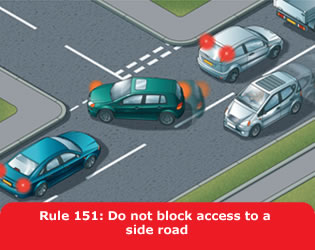
Residential streets. You should drive slowly and carefully on streets where there are likely to be pedestrians, cyclists and parked cars. In some areas a 20 mph (32 km/h) maximum speed limit may be in force. Look out for
Traffic-calming measures. On some roads there are features such as road humps, chicanes and narrowings which are intended to slow you down. When you approach these features reduce your speed. Allow cyclists and motorcyclists room to pass through them. Maintain a reduced speed along the whole of the stretch of road within the calming measures. Give way to oncoming road users if directed to do so by signs. You should not overtake other moving road users while in these areas.
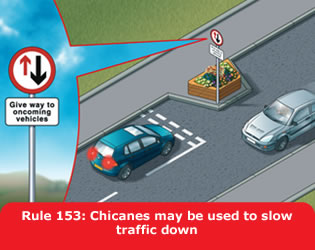
Take extra care on country roads and reduce your speed at approaches to bends, which can be sharper than they appear, and at junctions and turnings, which may be partially hidden. Be prepared for pedestrians, horse riders, cyclists, slow-moving farm vehicles or mud on the road surface. Make sure you can stop within the distance you can see to be clear. You should also reduce your speed where country roads enter villages.
Single-track roads. These are only wide enough for one vehicle. They may have special passing places. If you see a vehicle coming towards you, or the driver behind wants to overtake, pull into a passing place on your left, or wait opposite a passing place on your right. Give way to vehicles coming uphill whenever you can. If necessary, reverse until you reach a passing place to let the other vehicle pass. Slow down when passing pedestrians, cyclists and horse riders.
Do not park in passing places.
Certain motorised vehicles do not meet the construction and technical requirements for road vehicles and are generally not intended, not suitable and not legal for road, pavement, footpath, cycle path or bridleway use. These include most types of miniature motorcycles, also called mini motos, and motorised scooters, also called go peds, which are powered by electric or internal combustion engines. These types of vehicle MUST NOT be used on roads, pavements, footpaths or bridleways.
Laws RTA 1988 sects 34, 41a, 42, 47, 63 & 66, HA 1835, sect 72, & R(S)A sect 129
Certain models of motorcycles, motor tricycles and quadricycles, also called quad bikes, are suitable only for off-road use and do not meet legal standards for use on roads. Vehicles that do not meet these standards MUST NOT be used on roads. They MUST NOT be used on pavements, footpaths, cycle paths or bridleways either. You MUST make sure that any motorcycle, motor tricycle, quadricycle or any other motor vehicle meets legal standards and is properly registered, taxed and insured before using it on the roads. Even when registered, taxed and insured for the road, vehicles MUST NOT be used on pavements.
Laws RTA 1988 sects 34, 41a, 42, 47, 63, 66 & 156, HA 1835, sect 72, R(S)A sect 129, & VERA Ss 1, 29, 31A, & 43A
Before moving off you should
Move off only when it is safe to do so.
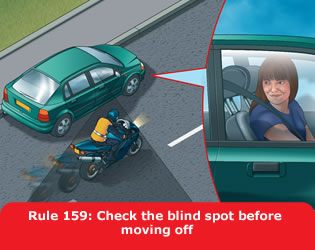
Once moving you should
Mirrors. All mirrors should be used effectively throughout your journey. You should
You will need to look round and check.
Remember: Mirrors – Signal – Manoeuvre
Before overtaking you should make sure
Overtake only when it is safe and legal to do so. You should
Remember: Mirrors – Signal – Manoeuvre

Large vehicles. Overtaking these is more difficult. You should

You MUST NOT overtake
DO NOT overtake if there is any doubt, or where you cannot see far enough ahead to be sure it is safe. For example, when you are approaching
DO NOT overtake where you might come into conflict with other road users. For example
Being overtaken. If a driver is trying to overtake you, maintain a steady course and speed, slowing down if necessary to let the vehicle pass. Never obstruct drivers who wish to pass. Speeding up or driving unpredictably while someone is overtaking you is dangerous. Drop back to maintain a two-second gap if someone overtakes and pulls into the gap in front of you.
Do not hold up a long queue of traffic, especially if you are driving a large or slow-moving vehicle. Check your mirrors frequently, and if necessary, pull in where it is safe and let traffic pass.
Take extra care at junctions. You should
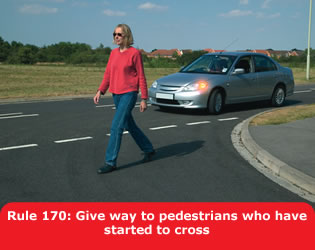
You MUST stop behind the line at a junction with a ‘Stop’ sign and a solid white line across the road. Wait for a safe gap in the traffic before you move off.
Laws RTA 1988 sect 36 & TSRGD regs 10 & 16
The approach to a junction may have a ‘Give Way’ sign or a triangle marked on the road. You MUST give way to traffic on the main road when emerging from a junction with broken white lines across the road.
Laws RTA 1988 sect 36 & TSRGD regs 10(1),16(1) & 25
Dual carriageways. When crossing or turning right, first assess whether the central reservation is deep enough to protect the full length of your vehicle.

Box junctions. These have criss-cross yellow lines painted on the road (see ‘Road markings’). You MUST NOT enter the box until your exit road or lane is clear. However, you may enter the box and wait when you want to turn right, and are only stopped from doing so by oncoming traffic, or by other vehicles waiting to turn right. At signalled roundabouts you MUST NOT enter the box unless you can cross over it completely without stopping.
Law TSRGD regs 10(1) & 29(2)

You MUST stop behind the white ‘Stop’ line across your side of the road unless the light is green. If the amber light appears you may go on only if you have already crossed the stop line or are so close to it that to stop might cause a collision.
Laws RTA 1988 sect 36 & TSRGD regs 10 & 36
You MUST NOT move forward over the white line when the red light is showing. Only go forward when the traffic lights are green if there is room for you to clear the junction safely or you are taking up a position to turn right. If the traffic lights are not working, treat the situation as you would an unmarked junction and proceed with great care.
Laws RTA 1988 sect 36 & TSRGD regs 10 & 36
Green filter arrow. This indicates a filter lane only. Do not enter that lane unless you want to go in the direction of the arrow. You may proceed in the direction of the green arrow when it, or the full green light shows. Give other traffic, especially cyclists, time and room to move into the correct lane.
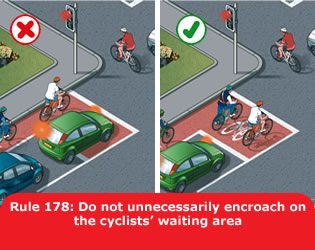
Advanced stop lines. Some signal-controlled junctions have advanced stop lines to allow cycles to be positioned ahead of other traffic. Motorists, including motorcyclists, MUST stop at the first white line reached if the lights are amber or red and should avoid blocking the way or encroaching on the marked area at other times, e.g. if the junction ahead is blocked. If your vehicle has proceeded over the first white line at the time that the signal goes red, you MUST stop at the second white line, even if your vehicle is in the marked area. Allow cyclists time and space to move off when the green signal shows.
Laws RTA 1988 sect 36 & TSRGD regs 10, 36(1) & 43(2)
Well before you turn right you should
Wait until there is a safe gap between you and any oncoming vehicle. Watch out for cyclists, motorcyclists, pedestrians and other road users. Check your mirrors and blind spot again to make sure you are not being overtaken, then make the turn. Do not cut the corner. Take great care when turning into a main road; you will need to watch for traffic in both directions and wait for a safe gap.
Remember: Mirrors – Signal – Manoeuvre
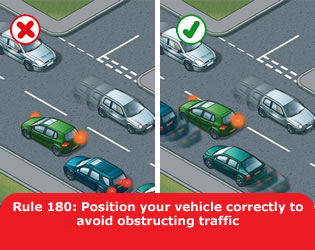
When turning right at crossroads where an oncoming vehicle is also turning right, there is a choice of two methods
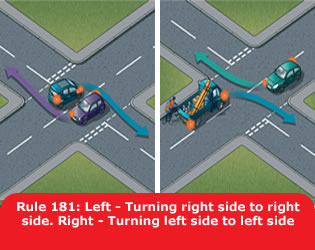
Use your mirrors and give a left-turn signal well before you turn left. Do not overtake just before you turn left and watch out for traffic coming up on your left before you make the turn, especially if driving a large vehicle. Cyclists, motorcyclists and other road users in particular may be hidden from your view.
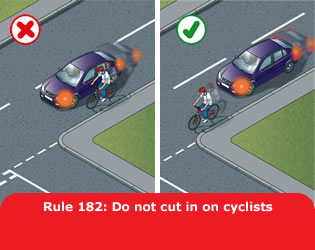
When turning
On approaching a roundabout take notice and act on all the information available to you, including traffic signs, traffic lights and lane markings which direct you into the correct lane. You should
When reaching the roundabout you should
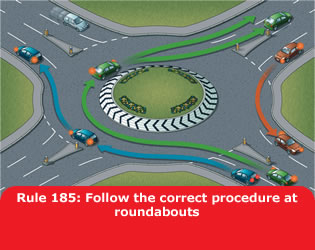
Signals and position
When taking the first exit to the left, unless signs or markings indicate otherwise
When taking an exit to the right or going full circle, unless signs or markings indicate otherwise
When taking any intermediate exit, unless signs or markings indicate otherwise
When there are more than three lanes at the entrance to a roundabout, use the most appropriate lane on approach and through it.
In all cases watch out for and give plenty of room to
Mini-roundabouts. Approach these in the same way as normal roundabouts. All vehicles MUST pass round the central markings except large vehicles which are physically incapable of doing so. Remember, there is less space to manoeuvre and less time to signal. Avoid making U-turns at mini-roundabouts. Beware of others doing this.
Laws RTA 1988 sect 36 & TSRGD regs 10(1) & 16(1)
At double mini-roundabouts treat each roundabout separately and give way to traffic from the right.
Multiple roundabouts. At some complex junctions, there may be a series of mini-roundabouts at each intersection. Treat each mini-roundabout separately and follow the normal rules.
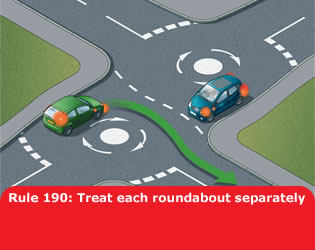
You MUST NOT park on a crossing or in the area covered by the zig-zag lines. You MUST NOT overtake the moving vehicle nearest the crossing or the vehicle nearest the crossing which has stopped to give way to pedestrians.
Laws ZPPPCRGD regs 18, 20 & 24, RTRA sect 25(5) & TSRGD regs 10, 27 & 28
In queuing traffic, you should keep the crossing clear.
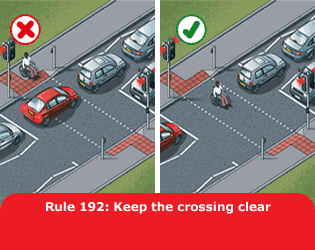
You should take extra care where the view of either side of the crossing is blocked by queuing traffic or incorrectly parked vehicles. Pedestrians may be crossing between stationary vehicles.
Allow pedestrians plenty of time to cross and do not harass them by revving your engine or edging forward.
Zebra crossings. As you approach a zebra crossing
A zebra crossing with a central island is two separate crossings (see pictures in Crossings (18 to 30)).
Law ZPPPCRGD reg 25
Pelican crossings. These are signal-controlled crossings where flashing amber follows the red ‘Stop’ light. You MUST stop when the red light shows. When the amber light is flashing, you MUST give way to any pedestrians on the crossing. If the amber light is flashing and there are no pedestrians on the crossing, you may proceed with caution.
Laws ZPPPCRGD regs 23 & 26 & RTRA sect 25(5)

Pelican crossings which go straight across the road are one crossing, even when there is a central island. You MUST wait for pedestrians who are crossing from the other side of the island.
Laws ZPPPCRGD reg 26 & RTRA sect 25(5)
Give way to anyone still crossing after the signal for vehicles has changed to green. This advice applies to all crossings.
Toucan, puffin and equestrian crossings. These are similar to pelican crossings, but there is no flashing amber phase; the light sequence for traffic at these three crossings is the same as at traffic lights. If the signal-controlled crossing is not working, proceed with extreme caution.
Choose an appropriate place to manoeuvre. If you need to turn your vehicle around, wait until you find a safe place. Try not to reverse or turn round in a busy road; find a quiet side road or drive round a block of side streets.
Do not reverse from a side road into a main road. When using a driveway, reverse in and drive out if you can.
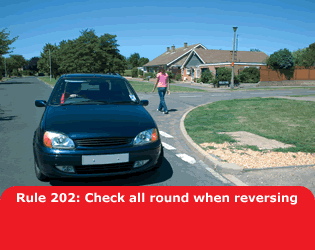
Look carefully before you start reversing. You should
Reverse slowly while
Get someone to guide you if you cannot see clearly.
You MUST NOT reverse your vehicle further than necessary.
Law CUR reg 106
The following list can be found abbreviated throughout the Code. It is not intended to be a comprehensive guide, but a guide to some of the important points of law. For the precise wording of the law, please refer to the various Acts and Regulations (as amended) indicated in the Code. Abbreviations are listed below.
Most of the provisions apply on all roads throughout Great Britain, although there are some exceptions. The definition of a road in England and Wales is ‘any highway and any other road to which the public has access and includes bridges over which a road passes’ (RTA 1988 sect 192(1)). In Scotland, there is a similar definition which is extended to include any way over which the public have a right of passage (R(S)A 1984 sect 151(1)).
It is important to note that references to ‘road’ therefore generally include footpaths, bridleways and cycle tracks, and many roadways and driveways on private land (including many car parks). In most cases, the law will apply to them and there may be additional rules for particular paths or ways. Some serious driving offences, including drink-driving offences, also apply to all public places, for example public car parks.
Acts and regulations from 1988 can be viewed on the UK legislation site. Acts and regulations prior to 1988 are only available in their original print format which may be obtained from The Stationery Office as detailed inside the back cover.
Chronically Sick & Disabled Persons Act 1970 CSDPA
Functions of Traffic Wardens Order 1970 FTWO
Greater London (General Powers) Act 1974 GL(GP)A
Highway Act 1835 or 1980 (as indicated) HA
Motorways Traffic (England & Wales) Regulations 1982 MT(E&W)R
Motorways Traffic (England & Wales) Amended Regulations MT(E&W)(A)R
Pedal Cycles (Construction & Use) Regulations 1983 PCUR
Public Passenger Vehicles Act 1981 PPVA
Road Traffic Act 1984 RTA
Road Traffic Regulation Act 1984 RTRA
Road Vehicles (Construction & Use) Regulations 1986 CUR
Roads (Scotland) Act 1984 R(S)A
Horses (Protective Headgear for Young Riders) Act 1990 H(PHYR)A
Horses (Protective Headgear for Young Riders) Regulations 1992 H(PHYR)R
Motor Cycles (Eye Protectors) Regulations 1999 MC(EP)R
Motor Cycles (Protective Helmets) Regulations 1998 MC(PH)R
Motorways Traffic (Scotland) Regulations 1995 MT(S)R
Motor Vehicles (Driving Licences) Regulations 1999 MV(DL)R
Motor Vehicles (Wearing of Seat Belts) Regulations 1993 MV(WSB)R
Motor Vehicles (Wearing of Seat Belts) (Amendment) Regulations 2006 MV(WSB)(A)R
Motor Vehicles (Wearing of Seat Belts by Children in Front Seats) Regulations 1993 MV(WSBCFS)R
New Roads and Streetworks Act 1991 NRSWA
Powers of Criminal Courts (Sentencing) Act 2000 PCC(S)A
Road Traffic (New Drivers) Act 1995 RT(ND)A
Road Traffic Offenders Act 1988 RTOA
Road Vehicles (Display of Registration Marks) Regulations 2001 RV(DRM)R
Road Vehicles Lighting Regulations 1989 RVLR
Road Vehicles (Registration & Licensing) Regulations 2002 RV(R&L)R
Smoke-free (Exemptions and Vehicles) Regulations 2007 SI 2007/765 TSf(EV)*
Smoke-free Premises etc (Wales) Regulations 2007 SI 2007/W787 TSfP(W)R*
Traffic Management Act 2004 TMA
Traffic Signs Regulations & General Directions 2002 TSRGD
Use of Invalid Carriages on Highways Regulations 1988 UICHR
Vehicle Excise and Registration Act 1994 VERA
Zebra, Pelican and Puffin Pedestrian Crossings Regulations and General Directions 1997 ZPPPCRGD
*Specific legislation applies to smoking in vehicles which constitute workplaces. For information, visit http://www.smokefreeengland.co.uk http://www.clearingtheairscotland.com http://www.smokingbanwales.co.uk
The most vulnerable road users are pedestrians, cyclists, motorcyclists and horse riders. It is particularly important to be aware of children, older and disabled people, and learner and inexperienced drivers and riders.
There is a risk of pedestrians, especially children, stepping unexpectedly into the road. You should drive with the safety of children in mind at a speed suitable for the conditions.
Drive carefully and slowly when
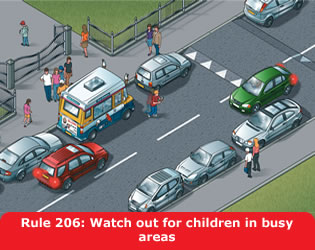
Particularly vulnerable pedestrians. These include:
Near schools. Drive slowly and be particularly aware of young cyclists and pedestrians. In some places, there may be a flashing amber signal below the ‘School’ warning sign which tells you that there may be children crossing the road ahead. Drive very slowly until you are clear of the area.
Drive carefully and slowly when passing a stationary bus showing a ‘School Bus’ sign (see ‘Vehicle markings’) as children may be getting on or off.
You MUST stop when a school crossing patrol shows a ‘Stop for children’ sign (see ‘Signals by authorised persons’ and ‘Traffic signs’).
Law RTRA sect 28
It is often difficult to see motorcyclists and cyclists, especially when they are coming up from behind, coming out of junctions, at roundabouts, overtaking you or filtering through traffic. Always look out for them before you emerge from a junction; they could be approaching faster than you think. When turning right across a line of slow-moving or stationary traffic, look out for cyclists or motorcyclists on the inside of the traffic you are crossing. Be especially careful when turning, and when changing direction or lane. Be sure to check mirrors and blind spots carefully.
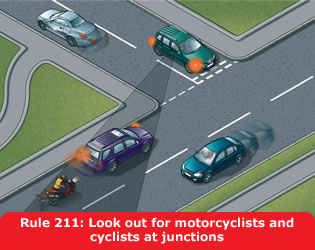
When passing motorcyclists and cyclists, give them plenty of room (see Rules 162, 163, 164, 165, 166 and 167). If they look over their shoulder it could mean that they intend to pull out, turn right or change direction. Give them time and space to do so.
Motorcyclists and cyclists may suddenly need to avoid uneven road surfaces and obstacles such as drain covers or oily, wet or icy patches on the road. Give them plenty of room and pay particular attention to any sudden change of direction they may have to make.
Animals. When passing animals, drive slowly. Give them plenty of room and be ready to stop. Do not scare animals by sounding your horn, revving your engine or accelerating rapidly once you have passed them. Look out for animals being led, driven or ridden on the road and take extra care. Keep your speed down at bends and on narrow country roads. If a road is blocked by a herd of animals, stop and switch off your engine until they have left the road. Watch out for animals on unfenced roads.
Horse riders and horse-drawn vehicles. Be particularly careful of horse riders and horse-drawn vehicles especially when overtaking. Always pass wide and slowly. Horse riders are often children, so take extra care and remember riders may ride in double file when escorting a young or inexperienced horse or rider. Look out for horse riders’ and horse drivers’ signals and heed a request to slow down or stop. Take great care and treat all horses as a potential hazard.
Older drivers. Their reactions may be slower than other drivers. Make allowance for this.
Learners and inexperienced drivers. They may not be so skilful at anticipating and responding to events. Be particularly patient with learner drivers and young drivers. Drivers who have recently passed their test may display a ‘new driver’ plate or sticker (see Safety code for new drivers).
Home Zones and Quiet Lanes. These are places where people could be using the whole of the road for a range of activities such as children playing or for a community event. You should drive slowly and carefully and be prepared to stop to allow people extra time to make space for you to pass them in safety.
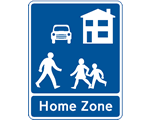
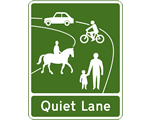
Emergency and Incident Support vehicles. You should look and listen for ambulances, fire engines, police, doctors or other emergency vehicles using flashing blue, red or green lights and sirens or flashing headlights, or Highways Agency Traffic Officer and Incident Support vehicles using flashing amber lights. When one approaches do not panic. Consider the route of such a vehicle and take appropriate action to let it pass, while complying with all traffic signs. If necessary, pull to the side of the road and stop, but try to avoid stopping before the brow of a hill, a bend or narrow section of road. Do not endanger yourself, other road users or pedestrians and avoid mounting the kerb. Do not brake harshly on approach to a junction or roundabout, as a following vehicle may not have the same view as you.
Powered vehicles used by disabled people. These small vehicles travel at a maximum speed of 8 mph (12 km/h). On a dual carriageway where the speed limit exceeds 50 mph (80 km/h) they MUST have a flashing amber beacon, but on other roads you may not have that advance warning (see Rules 36, 37, 38, 39, 40, 41, 42, 43, 44, 45 and 46).
Law RVLR reg 17(1) & 26
Large vehicles. These may need extra road space to turn or to deal with a hazard that you are not able to see. If you are following a large vehicle, such as a bus or articulated lorry, be aware that the driver may not be able to see you in the mirrors. Be prepared to stop and wait if it needs room or time to turn.
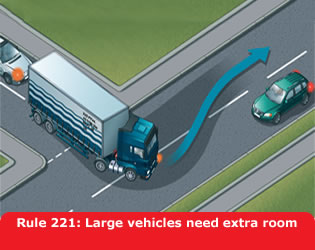
Large vehicles can block your view. Your ability to see and to plan ahead will be improved if you pull back to increase your separation distance. Be patient, as larger vehicles are subject to lower speed limits than cars and motorcycles. Many large vehicles may be fitted with speed limiting devices which will restrict speed to 56 mph (90 km/h) even on a motorway.
Buses, coaches and trams. Give priority to these vehicles when you can do so safely, especially when they signal to pull away from stops. Look out for people getting off a bus or tram and crossing the road.
Electric vehicles. Be careful of electric vehicles such as milk floats and trams. Trams move quickly but silently and cannot steer to avoid you.
Vehicles with flashing amber beacons. These warn of a slow-moving or stationary vehicle (such as a Traffic Officer vehicle, salt spreader, snow plough or recovery vehicle) or abnormal loads, so approach with caution. On unrestricted dual carriageways, motor vehicles first used on or after 1 January 1947 with a maximum speed of 25 mph (40 km/h) or less (such as tractors) MUST use a flashing amber beacon (also see Rule 220 above). Law RVLR 1989, reg 17
You MUST use headlights when visibility is seriously reduced, generally when you cannot see for more than 100 metres (328 feet). You may also use front or rear fog lights but you MUST switch them off when visibility improves (see Rule 236). Law RVLR regs 25 & 27
Wet weather. In wet weather, stopping distances will be at least double those required for stopping on dry roads (see ‘Typical stopping distances). This is because your tyres have less grip on the road. In wet weather
In winter check the local weather forecast for warnings of icy or snowy weather. DO NOT drive in these conditions unless your journey is essential. If it is, take great care and allow more time for your journey. Take an emergency kit of de-icer and ice scraper, torch, warm clothing and boots, first aid kit, jump leads and a shovel, together with a warm drink and emergency food in case you get stuck or your vehicle breaks down.
Before you set off
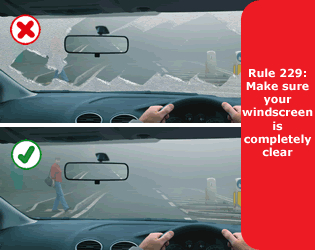
When driving in icy or snowy weather
Drive extremely carefully when the roads are icy. Avoid sudden actions as these could cause loss of control. You should
High-sided vehicles are most affected by windy weather, but strong gusts can also blow a car, cyclist, motorcyclist or horse rider off course. This can happen on open stretches of road exposed to strong crosswinds, or when passing bridges or gaps in hedges.
In very windy weather your vehicle may be affected by turbulence created by large vehicles. Motorcyclists are particularly affected, so keep well back from them when they are overtaking a high-sided vehicle.
Before entering fog check your mirrors then slow down. If the word ‘Fog’ is shown on a roadside signal but the road is clear, be prepared for a bank of fog or drifting patchy fog ahead. Even if it seems to be clearing, you can suddenly find yourself in thick fog.
When driving in fog you should
You MUST NOT use front or rear fog lights unless visibility is seriously reduced (see Rule 226) as they dazzle other road users and can obscure your brake lights. You MUST switch them off when visibility improves.
Law RVLR regs 25 & 27
Keep your vehicle well ventilated to avoid drowsiness. Be aware that the road surface may become soft or if it rains after a dry spell it may become slippery. These conditions could affect your steering and braking. If you are dazzled by bright sunlight, slow down and if necessary, stop.
You MUST NOT wait or park on yellow lines during the times of operation shown on nearby time plates (or zone entry signs if in a Controlled Parking Zone) – see ‘Traffic signs’ and ‘Road markings’. Double yellow lines indicate a prohibition of waiting at any time even if there are no upright signs. You MUST NOT wait or park, or stop to set down and pick up passengers, on school entrance markings (see ‘Road markings’) when upright signs indicate a prohibition of stopping.
Law RTRA sects 5 & 8
Use off-street parking areas, or bays marked out with white lines on the road as parking places, wherever possible. If you have to stop on the roadside:
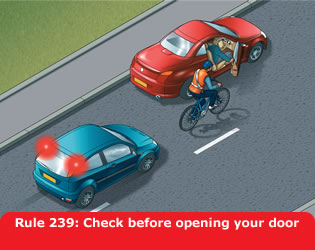
You MUST NOT stop or park on:
You MUST NOT park in parking spaces reserved for specific users, such as Blue Badge holders, residents or motorcycles, unless entitled to do so.
Laws CSDPA sect 21 & RTRA sects 5 & 8
You MUST NOT leave your vehicle or trailer in a dangerous position or where it causes any unnecessary obstruction of the road.
Laws RTA 1988, sect 22 & CUR reg 103
DO NOT stop or park:
You MUST NOT park partially or wholly on the pavement in London, and should not do so elsewhere unless signs permit it. Parking on the pavement can obstruct and seriously inconvenience pedestrians, people in wheelchairs or with visual impairments and people with prams or pushchairs.
Law GL(GP)A sect 15
Controlled Parking Zones. The zone entry signs indicate the times when the waiting restrictions within the zone are in force. Parking may be allowed in some places at other times. Otherwise parking will be within separately signed and marked bays.
Goods vehicles. Vehicles with a maximum laden weight of over 7.5 tonnes (including any trailer) MUST NOT be parked on a verge, pavement or any land situated between carriageways, without police permission. The only exception is when parking is essential for loading and unloading, in which case the vehicle MUST NOT be left unattended.
Law RTA 1988 sect 19
Loading and unloading. Do not load or unload where there are yellow markings on the kerb and upright signs advise restrictions are in place (see pages 115-116). This may be permitted where parking is otherwise restricted. On red routes, specially marked and signed bays indicate where and when loading and unloading is permitted.
Law RTRA sects 5 & 8
You MUST NOT park on a road at night facing against the direction of the traffic flow unless in a recognised parking space. Laws CUR reg 101 & RVLR reg 24
All vehicles MUST display parking lights when parked on a road or a lay-by on a road with a speed limit greater than 30 mph (48 km/h).
Law RVLR reg 24
Cars, goods vehicles not exceeding 1525 kg unladen weight, invalid carriages, motorcycles and pedal cycles may be parked without lights on a road (or lay-by) with a speed limit of 30 mph (48 km/h) or less if they are:
Other vehicles and trailers, and all vehicles with projecting loads, MUST NOT be left on a road at night without lights.
Laws RVLR reg 24 & CUR reg 82(7)
Parking in fog. It is especially dangerous to park on the road in fog. If it is unavoidable, leave your parking lights or sidelights on.
Parking on hills. If you park on a hill you should:
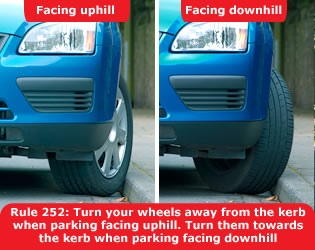
DPE is becoming increasingly common as more authorities take on this role. The local traffic authority assumes responsibility for enforcing many parking contraventions in place of the police. Further details on DPE may be found at the following websites:
Traffic penalty tribunal (outside London)
Parking and traffic appeals service (inside London)
Many other Rules apply to motorway driving, either wholly or in part: Rules 46, 57, 83, 84, 85, 86, 87, 88, 89, 90, 91, 92, 93, 94, 95, 96, 97, 98, 99, 100, 101, 102, 103, 104, 105, 106, 107, 108, 109, 110, 111, 112, 113, 114, 115, 116, 117, 118, 119, 120, 121, 122, 123, 124, 125, 126, 130, 131, 132, 133, 134, 139, 144, 146, 147, 148, 149, 150, 151, 160, 161, 219, 221, 222, 225, 226, 227, 228, 229, 230, 231, 232, 233, 234, 235, 236, 237, 274, 275, 276, 277, 278, 280, 281, 282, 283, 284, 285, 286, 287, 288, 289 and 290.
Prohibited vehicles. Motorways MUST NOT be used by pedestrians, holders of provisional motorcycle or car licences, riders of motorcycles under 50 cc, cyclists, horse riders, certain slow-moving vehicles and those carrying oversized loads (except by special permission), agricultural vehicles, and powered wheelchairs/powered mobility scooters (see Rules 36, 37, 38, 39, 40, 41, 42, 43, 44, 45 and 46)
Laws HA 1980 sects 16, 17 & sch 4, MT(E&W)R regs 3(d), 4 & 11, MT(E&W)(A)R, R(S)A sects 7, 8 & sch 3, RTRA sects 17(2) & (3), & MT(S)R reg 10
Traffic on motorways usually travels faster than on other roads, so you have less time to react. It is especially important to use your mirrors earlier and look much further ahead than you would on other roads.
Motorway signals (see ‘Light signals controlling traffic’) are used to warn you of a danger ahead. For example, there may be an incident, fog, a spillage or road workers on the carriageway which you may not immediately be able to see.
Signals situated on the central reservation apply to all lanes. On very busy stretches, signals may be overhead with a separate signal for each lane.
Amber flashing lights. These warn of a hazard ahead. The signal may show a temporary maximum speed limit, lanes that are closed or a message such as ‘Fog’. Adjust your speed and look out for the danger until you pass a signal which is not flashing or one that gives the ‘All clear’ sign and you are sure it is safe to increase your speed.
Red flashing lights. If red lights on the overhead signals flash above your lane and a red ‘X’ is showing, you MUST NOT go beyond the signal in that lane. If red lights flash on a signal in the central reservation or at the side of the road, you MUST NOT go beyond the signal in any lane.
Laws RTA 1988 sect 36 & TSRGD regs 10 & 38
Joining the motorway. When you join the motorway you will normally approach it from a road on the left (a slip road) or from an adjoining motorway. You should:
When you can see well ahead and the road conditions are good, you should:
You MUST NOT exceed 70 mph (112 km/h), or the maximum speed limit permitted for your vehicle (see Speed limits table). If a lower speed limit is in force, either permanently or temporarily, at road works for example, you MUST NOT exceed the lower limit. On some motorways, mandatory motorway signals (which display the speed within a red ring) are used to vary the maximum speed limit to improve traffic flow. You MUST NOT exceed this speed limit.
Law RTRA sects 17, 86, 89 & sch 6
The monotony of driving on a motorway can make you feel sleepy. To minimise the risk, follow the advice in Rule 91.
You MUST NOT reverse, cross the central reservation, or drive against the traffic flow. If you have missed your exit, or have taken the wrong route, carry on to the next exit.
Laws MT(E&W)R regs 6, 8 & 10 & MT(S)R regs 4, 5, 7 & 9
You should always drive in the left-hand lane when the road ahead is clear. If you are overtaking a number of slower-moving vehicles, you should return to the left-hand lane as soon as you are safely past. Slow-moving or speed-restricted vehicles should always remain in the left-hand lane of the carriageway unless overtaking. You MUST NOT drive on the hard shoulder except in an emergency or if directed to do so by the police, HA traffic officers in uniform or by signs.
Laws MT(E&W)R regs 5, 9 & 16(1)(a), MT(S)R regs 4, 8 & 14(1)(a), and RTA 1988, sects 35 & 186, as amended by TMA 2004 sect 6
The right-hand lane of a motorway with three or more lanes MUST NOT be used (except in prescribed circumstances) if you are driving:
Approaching a junction. Look well ahead for signals or signs. Direction signs may be placed over the road. If you need to change lanes, do so in good time. At some junctions a lane may lead directly off the motorway. Only get in that lane if you wish to go in the direction indicated on the overhead signs.
Do not overtake unless you are sure it is safe and legal to do so. Overtake only on the right. You should:
Do not overtake on the left or move to a lane on your left to overtake. In congested conditions, where adjacent lanes of traffic are moving at similar speeds, traffic in left-hand lanes may sometimes be moving faster than traffic to the right. In these conditions you may keep up with the traffic in your lane even if this means passing traffic in the lane to your right. Do not weave in and out of lanes to overtake.
Hard shoulder. You MUST NOT use the hard shoulder for overtaking. In areas where an Active Traffic Management (ATM) Scheme is in force, the hard shoulder may be used as a running lane. You will know when you can use this because a speed limit sign will be shown above all open lanes, including the hard shoulder. A red cross or blank sign above the hard shoulder means that you MUST NOT drive on the hard shoulder except in an emergency or breakdown. Emergency refuge areas have also been built into these areas for use in cases of emergency or breakdown.
Laws MT(E&W)R regs 5, 5A & 9, MT(S)R regs 4 & 8
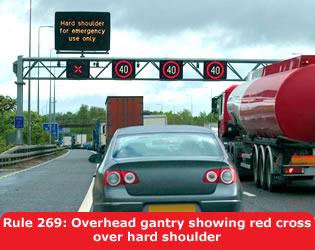
You MUST NOT stop on the carriageway, hard shoulder, slip road, central reservation or verge except in an emergency, or when told to do so by the police, HA traffic officers in uniform, an emergency sign or by flashing red light signals. Do not stop on the hard shoulder to either make or receive mobile phone calls.
Laws MT(E&W)R regs 5A, 7, 9, 10 & 16,MT(S)R regs 6(1), 8, 9 & 14, PRA 2002 sect 41 & sched 5(8), & RTA 1988 sects 35 & 163 as amended by TMA 2004, sect 6
You MUST NOT pick up or set down anyone, or walk on a motorway, except in an emergency.
Laws RTRA sect 17 & MT(E&W)R reg 15
Unless signs indicate that a lane leads directly off the motorway, you will normally leave the motorway by a slip road on your left. You should:
On leaving the motorway or using a link road between motorways, your speed may be higher than you realise - 50 mph may feel like 30 mph. Check your speedometer and adjust your speed accordingly. Some slip-roads and link roads have sharp bends, so you will need to slow down.
If your vehicle breaks down, think first of all other road users and:
If your vehicle develops a problem, leave the motorway at the next exit or pull into a service area. If you cannot do so, you should:
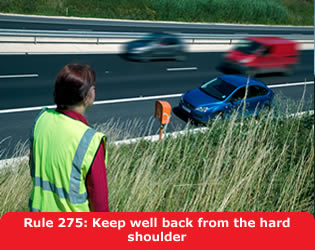
Before you rejoin the carriageway after a breakdown, build up speed on the hard shoulder and watch for a safe gap in the traffic. Be aware that other vehicles may be stationary on the hard shoulder.
If you cannot get your vehicle onto the hard shoulder:
Disabled drivers. If you have a disability which prevents you from following the above advice you should:
If anything falls from your vehicle (or any other vehicle) on to the road, stop and retrieve it only if it is safe to do so.
Motorways. On a motorway do not try to remove the obstruction yourself. Stop at the next emergency telephone and call the Highways Agency or the police.
Warning signs or flashing lights. If you see or hear emergency or incident support vehicles in the distance, be aware there may be an incident ahead (see Rule 219). Police Officers and Highways Agency Traffic Officers may be required to work in the carriageway, for example dealing with debris, collisions or conducting rolling road blocks. Police officers will use rear-facing flashing red and blue lights and HA Traffic Officers will use rear-facing flashing red and amber lights in these situations. Watch out for such signals, slow down and be prepared to stop. You MUST follow any directions given by Police officers or Traffic officers as to whether you can safely pass the incident or blockage.
Laws RTA1988, sects 35 &163, and as amended by TMA 2004, sect 6
When passing the scene of an incident or crash do not be distracted or slow down unnecessarily (for example if an incident is on the other side of a dual carriageway). This may cause a collision or traffic congestion, but see Rule 283, below.
If you are involved in a crash or stop to give assistance
Vehicles carrying dangerous goods in packages will be marked with plain orange reflective plates. Road tankers and vehicles carrying tank containers of dangerous goods will have hazard warning plates (see ‘Vehicle markings’).
If an incident involves a vehicle containing dangerous goods, follow the advice in Rule 283 and, in particular:
If you are involved in a collision which causes damage or injury to any other person, vehicle, animal or property, you MUST
If another person is injured and you do not produce your insurance certificate at the time of the crash to a police officer or to anyone having reasonable grounds to request it, you MUST
When the ‘Road Works Ahead’ sign is displayed, you will need to be more watchful and look for additional signs providing more specific instructions. Observe all signs - they are there for your safety and the safety of road workers.
Take special care on motorways and other high-speed dual carriageways.
Contraflow systems mean that you may be travelling in a narrower lane than normal and with no permanent barrier between you and oncoming traffic. The hard shoulder may be used for traffic, but be aware that there may be broken-down vehicles ahead of you. Keep a good distance from the vehicle ahead and observe any temporary speed limits.
A level crossing is where a road crosses a railway or tramway line. Approach and cross it with care. Never drive onto a crossing until the road is clear on the other side and do not get too close to the car in front. Never stop or park on, or near, a crossing.
It is dangerous to touch overhead electric lines. You MUST obey the safe height warning road signs and you should not continue forward onto the railway if your vehicle touches any height barrier or bells. The clearance available is usually 5 metres (16 feet 6 inches) but may be lower.
Laws RTA 1988 sect 36, TSRGD 2002 reg 17(5)
Controlled Crossings. Most crossings have traffic light signals with a steady amber light, twin flashing red stop lights (see ‘Light signals controlling traffic’ and ‘Traffic signs’) and an audible alarm for pedestrians. They may have full, half or no barriers.
Laws RTA 1988 sect 36 & TSRGD regs 10 & 40

Railway telephones. If you are driving a large or slow- moving vehicle, a long, low vehicle with a risk of grounding, or herding animals, a train could arrive before you are clear of the crossing. You MUST obey any sign instructing you to use the railway telephone to obtain permission to cross. You MUST also telephone when clear of the crossing if requested to do so.
Laws RTA 1988 sect 36 & TSRGD regs 10 & 16(1)
Crossings without traffic lights. Vehicles should stop and wait at the barrier or gate when it begins to close and not cross until the barrier or gate opens.
User-operated gates or barriers. Some crossings have ‘Stop’ signs and small red and green lights. You MUST NOT cross when the red light is showing, only cross if the green light is on. If crossing with a vehicle, you should:
Laws RTA 1988 sect 36 & TSRGD regs 10 & 52(2)
If there are no lights, follow the procedure in Rule 295. Stop, look both ways and listen before you cross. If there is a railway telephone, always use it to contact the signal operator to make sure it is safe to cross. Inform the signal operator again when you are clear of the crossing.
Open crossings. These have no gates, barriers, attendant or traffic lights but will have a ‘Give Way’ sign. You should look both ways, listen and make sure there is no train coming before you cross.
Incidents and breakdowns. If your vehicle breaks down, or if you have an incident on a crossing you should:
You MUST NOT enter a road, lane or other route reserved for trams. Take extra care where trams run along the road. You should avoid driving directly on top of the rails and should take care where trams leave the main carriageway to enter the reserved route, to ensure you do not follow them. The width taken up by trams is often shown by tram lanes marked by white lines, yellow dots or by a different type of road surface. Diamond-shaped signs and white light signals give instructions to tram drivers only.
Law RTRA sects 5 & 8
Take extra care where the track crosses from one side of the road to the other and where the road narrows and the tracks come close to the kerb. Tram drivers usually have their own traffic signals and may be permitted to move when you are not. Always give way to trams. Do not try to race or overtake them or pass them on the inside, unless they are at tram stops or stopped by tram signals and there is a designated tram lane for you to pass.
You MUST NOT park your vehicle where it would get in the way of trams or where it would force other drivers to do so. Do not stop on any part of a tram track, except in a designated bay where this has been provided alongside and clear of the track. When doing so, ensure that all parts of your vehicle are outside the delineated tram path. Remember that a tram cannot steer round an obstruction.
Law RTRA sects 5 & 8
Tram stops. Where the tram stops at a platform, either in the middle or at the side of the road, you MUST follow the route shown by the road signs and markings. At stops without platforms you MUST NOT drive between a tram and the left-hand kerb when a tram has stopped to pick up passengers. If there is no alternative route signed, do not overtake the tram - wait until it moves off.
Law RTRA sects 5 & 8
Look out for pedestrians, especially children, running to catch a tram approaching a stop.
Always give priority to trams, especially when they signal to pull away from stops, unless it would be unsafe to do so. Remember that they may be carrying large numbers of standing passengers who could be injured if the tram had to make an emergency stop. Look out for people getting off a bus or tram and crossing the road.
All road users, but particularly cyclists and motorcyclists, should take extra care when driving or riding close to or crossing the tracks, especially if the rails are wet. You should take particular care when crossing the rails at shallow angles, on bends and at junctions. It is safest to cross the tracks directly at right angles. Other road users should be aware that cyclists and motorcyclists may need more space to cross the tracks safely.
Overhead electric lines. Tramway overhead wires are normally 5.8 metres above any carriageway, but can be lower. You should ensure that you have sufficient clearance between the wire and your vehicle (including any load you are carrying) before driving under an overhead wire. Drivers of vehicles with extending cranes, booms, tipping apparatus or other types of variable height equipment should ensure that the equipment is fully lowered. Where overhead wires are set lower than 5.8 metres, these will be indicated by height clearance markings - similar to ‘low bridge’ signs. The height clearances on these plates should be carefully noted and observed. If you are in any doubt as to whether your vehicle will pass safely under the wires, you should always contact the local police or the tramway operator. Never take a chance as this can be extremely hazardous.
This Highway Code applies to England, Scotland and Wales. The Highway Code is essential reading for everyone.
Parliament sets the maximum penalties for road traffic offences. The seriousness of the offence is reflected in the maximum penalty. It is for the courts to decide what sentence to impose according to circumstances.
The penalty table indicates some of the main offences, and the associated penalties. There is a wide range of other more specific offences which, for the sake of simplicity, are not shown here. The penalty points and disqualification system is described below.
The penalty point system is intended to deter drivers and motorcyclists from following unsafe motoring practices. Certain non-motoring offences, e.g. failure to rectify vehicle defects, can also attract penalty points.
The court MUST order points to be endorsed on the licence according to the fixed number or the range set by Parliament. The accumulation of penalty points acts as a warning to drivers and motorcyclists that they risk disqualification if further offences are committed.
Law RTOA sects 44 & 45
A driver or motorcyclist who accumulates 12 or more penalty points within a 3-year period MUST be disqualified. This will be for a minimum period of 6 months, or longer if the driver or motorcyclist has previously been disqualified.
Law RTOA sect 35
For every offence which carries penalty points the court has a discretionary power to order the licence holder to be disqualified. This may be for any period the court thinks fit, but will usually be between a week and a few months.
In the case of serious offences, such as dangerous driving and drink-driving, the court MUST order disqualification. The minimum period is 12 months, but for repeat offenders or where the alcohol level is high, it may be longer. For example, a second drink-drive offence in the space of 10 years will result in a minimum of 3 years’ disqualification.
Law RTOA sect 34
| Offence | Maximum penalty | Penalty points |
|---|---|---|
| *Causing death by dangerous driving | 14 years’ imprisonment / Unlimited fine / Obligatory disqualification (minimum 2 years) | 3 to 11 (if exceptionally not disqualified) |
| *Dangerous driving | 2 years’ imprisonment / Unlimited fine / Obligatory disqualification | 3 to 11 (if exceptionally not disqualified) |
| *Causing death by careless driving under the influence of drink or drugs | 14 years’ imprisonment / Unlimited fine / Obligatory disqualification (minimum 2 years) | 3 to 11 (if exceptionally not disqualified) |
| Careless and inconsiderate driving | £5,000 fine / Discretionary disqualification | 3 to 9 |
| Driving while unfit through drink or drugs or with excess alcohol: or failing to provide a specimen for analysis | 6 months’ imprisonment / £5,000 fine / Obligatory disqualification | 3 to 11 (if exceptionally not disqualified) |
| Failing to stop after an accident or failing to report an accident | 6 months’ imprisonment / £5,000 fine / Discretionary disqualification | 5 to 10 |
| Driving while disqualified | 6 months’ imprisonment (12 months in Scotland) / £5,000 fine / Discretionary disqualification | 6 |
| Driving after refusal or revocation of licence on medical grounds | 6 months’ imprisonment / £5,000 fine / Discretionary disqualification | 3 to 6 |
| Driving without insurance | £5,000 fine / Discretionary disqualification | 6 to 8 |
| Using a vehicle in a dangerous condition | £2,500 fine (£5,000 for PCV or LGV) / Obligatory disqualification (6 months) if the offence is committed within 3 years of a conviction for the same offence | 3 |
| Failure to have proper control of vehicle or full view of the road and traffic ahead, or using a hand-held mobile phone when driving | £1,000 fine (£2,500 for PCV or goods vehicle) / Discretionary disqualification | 3 |
| Driving otherwise than in accordance with a licence | £1,000 fine / Discretionary disqualification | 3 to 6 |
| Speeding | £1,000 fine (£2,500 for motorway offences) / Discretionary disqualification | 3 to 6, or 3 (fixed penalty) |
| Traffic light offences | £1,000 fine / Discretionary disqualification | 3 |
| No MOT certificate | £1,000 fine | - |
| Seat belt offences | £500 fine | - |
| Dangerous cycling | £1,000 fine | - |
| Careless cycling | £1,000 fine | - |
| Cycling on pavement | £500 fine | - |
| Failing to identify driver of vehicle | £1,000 fine / Discretionary disqualification | 6 |
Special rules as set out below apply for a period of two years from the date of passing their first driving test, to drivers and motorcyclists from
Where a person subject to the special rules accumulates 6 or more penalty points before the end of the 2-year period (including any points acquired before passing the test) their licence will be revoked automatically. To regain the licence they MUST reapply for a provisional licence and may drive only as a learner until they pass a further driving test (also see Annex 8 – Safety code for new drivers.)
Law RT(ND)A
Note. This applies even if they pay for offences by fixed penalty. Drivers in the first group (UK, EU/EEA etc.) who already have a full licence for one type of vehicle are not affected by the special rules if they later pass a test to drive another type of vehicle.
Where an offence is punishable by imprisonment then the vehicle used to commit the offence may be confiscated.
Law PCC(S)A, sect 143
In addition to the penalties a court may decide to impose, the cost of insurance is likely to rise considerably following conviction for a serious driving offence. This is because insurance companies consider such drivers are more likely to be involved in a collision.
Drivers disqualified for drinking and driving twice within 10 years, or once if they are over 2 and a half times the legal limit, or those who refused to give a specimen, also have to satisfy the Driver and Vehicle Licensing Agency’s Medical Branch that they do not have an alcohol problem and are otherwise fit to drive before their licence is returned at the end of their period of disqualification. Persistent misuse of drugs or alcohol may lead to the withdrawal of a driving licence.
Take special care that lights, brakes, steering, exhaust system, seat belts, demisters, wipers and washers are all working. Also
Warning displays. Make sure that you understand the meaning of all warning displays on the vehicle instrument panel. Do not ignore warning signs, they could indicate a dangerous fault developing.
Window tints. You MUST NOT use a vehicle with excessively dark tinting applied to the windscreen, or to the glass in any front window to either side of the driver. Window tinting applied during manufacture complies with the Visual Light Transmittance (VLT) standards. There are no VLT limits for rear windscreens or rear passenger windows.
Laws RTA 1988 sect 42 & CUR reg 32
Tyres. Tyres MUST be correctly inflated to the vehicle manufacturer’s specification for the load being carried. Always refer to the vehicle’s handbook or data. Tyres should also be free from certain cuts and other defects.
Cars, light vans and light trailers MUST have a tread depth of at least
1.6 mm across the central three-quarters of the breadth of the tread and around the entire circumference.
Motorcycles, large vehicles and passenger-carrying vehicles MUST have a tread depth of at least 1 mm across three-quarters of the breadth of the tread and in a continuous band around the entire circumference.
Mopeds should have visible tread.
Be aware that some vehicle defects can attract penalty points.
Law CUR reg 27
If a tyre bursts while you are driving, try to keep control of your vehicle. Grip the steering wheel firmly and allow the vehicle to roll to a stop at the side of the road.
If you have a flat tyre, stop as soon as it is safe to do so. Only change the tyre if you can do so without putting yourself or others at risk – otherwise call a breakdown service.
Tyre pressures. Check weekly. Do this before your journey, when tyres are cold. Warm or hot tyres may give a misleading reading.
Your brakes and steering will be adversely affected by under-inflated or over-inflated tyres. Excessive or uneven tyre wear may be caused by faults in the braking or suspension systems, or wheels which are out of alignment. Have these faults corrected as soon as possible.
Fluid levels. Check the fluid levels in your vehicle at least weekly. Low brake fluid may result in brake failure and a crash. Make sure you recognise the low fluid warning lights if your vehicle has them fitted.
Before winter. Ensure that the battery is well maintained and that there are appropriate anti-freeze agents in your radiator and windscreen bottle.
Other problems. If your vehicle
Overheated engines or fire. Most engines are water-cooled. If your engine overheats you should wait until it has cooled naturally. Only then remove the coolant filler cap and add water or other coolant.
If your vehicle catches fire, get the occupants out of the vehicle quickly and to a safe place. Do not attempt to extinguish a fire in the engine compartment, as opening the bonnet will make the fire flare. Call the fire brigade.
Petrol stations/fuel tank/fuel leaks. Ensure that, when filling up your vehicle’s tank or any fuel cans you are carrying, you do not spill fuel on the forecourt. Any spilled fuel should be immediately reported to the petrol station attendant. Diesel spillage is dangerous to other road users, particularly motorcyclists, as it will significantly reduce the level of grip between the tyres and road surface. Double-check for fuel leaks and make sure that - you do not overfill your fuel tank - the fuel cap is fastened securely - the seal in the cap is not torn, perished or missing - there is no visual damage to the cap or the fuel tank
Emergency fuel caps, if fitted, should form a good seal.
Never smoke, or use a mobile phone, on the forecourt of petrol stations as these are major fire risks and could cause an explosion.
When you leave your vehicle you should
For extra security fit an anti-theft device such as an alarm or immobiliser. If you are buying a new car it is a good idea to check the level of built-in security features. Consider having your registration number etched on all your car windows. This is a cheap and effective deterrent to professional thieves.
All content is available under the Open Government Licence v2.0, except where otherwise stated